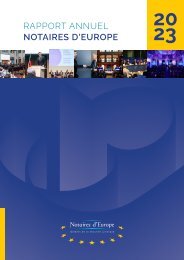CNUE - THE FIGHT AGAINST MONEY LAUNDERING
THE FIGHT AGAINST MONEY LAUNDERING - AN INTERNATIONAL COMBAT, A EUROPEAN CHALLENGE Money laundering is a multifaceted phenomenon. First of all, it is neither static nor temporary: it is constantly evolving, finding new resources in an ever-increasing financial globalisation and the evolution of technology. It is also a phenomenon that is inherently transnational, not only disregarding borders, but using them to blur the trail of successive financial transactions across the globe and obstructing the course of justice. Finally, it is a phenomenon that is on the increase. According to an estimate by the Financial Action Task Force (FATF), the annual volume of money laundering operations is estimated at between 2 and 5% of global GDP.
THE FIGHT AGAINST MONEY LAUNDERING - AN INTERNATIONAL COMBAT, A EUROPEAN CHALLENGE
Money laundering is a multifaceted phenomenon. First of all, it is neither static nor temporary: it is constantly evolving, finding new resources in an ever-increasing financial globalisation and the evolution of technology. It is also a phenomenon that is inherently transnational, not only disregarding borders, but using them to blur the trail of successive financial transactions across the globe and obstructing the course of justice. Finally, it is a phenomenon that is on the increase. According to an estimate by the Financial Action Task Force (FATF), the annual volume of money laundering operations is estimated at between 2 and 5% of global GDP.
Create successful ePaper yourself
Turn your PDF publications into a flip-book with our unique Google optimized e-Paper software.
Notaries and the risk-based
approach (RBA)
What is meant by RBA is that the extent
and intensity of the measures to be
adopted by the notary will depend
on a case-by-case assessment which is
to consider, at any rate, the purpose of
the business, the amount of the assets
involved, the scope of the transactions and
the regularity or duration of the business
relationship. Moreover, the notary must also
include his own risk assessment for his office
and the (demonstrative) factors suggestive of
potentially higher or lower risk.
The measures the notary adopts on the
basis of a risk-oriented assessment of the
individual case must be transparent and
verifiable.
The implementation of the RBA therefore
requires the risk identification and
assessment, the risk management and
mitigation, the ongoing monitoring of
changes to risks and the documentation of
risk assessments and measures to monitor,
manage and mitigate risks.
The general principle of an RBA is that,
where there are higher risks, countries
should require financial institutions and
DNFBPs to take enhanced measures to
manage and mitigate those risks; and that,
correspondingly, where the risks are lower,
simplified measures may be permitted.
Simplified measures should not be permitted
whenever there is a suspicion of money
laundering or terrorist financing.
The RBA to AML/CFT means that countries,
competent authorities and DNFBPs, including
notaries and other legal professionals, should
identify, assess and understand the ML/TF
risks to which they are exposed and take the
required AML/CFT measures effectively and
efficiently to mitigate and manage the risks.
Stephan Matyk-d’Anjony,
Österreichische Notariatskammer (Austria)
The RBA is considered as being an effective
way to combat money laundering and
terrorist financing. In the implementation of
an RBA, financial institutions and designated
non-financial businesses and professions
(DNFBPs) should have processes in place
to identify, assess, monitor, manage and
mitigate money laundering and terrorist
financing risks.
13
















